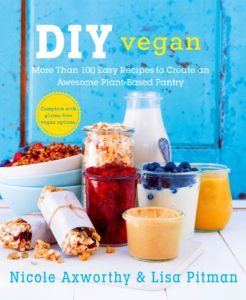DIY vegan : more than 100 easy recipes to create an awesome plant-based pantry. / Nicole Axworthy and Lisa Pitman. Published by St. Martin’s Griffin, New York, 2015. 240 pages, with color illustrations.

Some of the best tastes to come out of my kitchen have been created using pantry staples, or vegan and gluten-free pantry staples. Take sour cream, Indian chai spice, and blueberry scones, all made from stock mixtures I learned about online or from magazines. So I was intrigued by DIY vegan : more than 100 easy recipes to create an awesome plant-based pantry, which promised so much more with vegan and gluten-free baking staples, seasoning staples, and sweets. I was eager to get started and broaden my pantry selections.
First, lest you might pre-judge vegan pantry items to be far too complicated to create at home, know that while taste-worthy, the recipes only mimic comfort food, yet cooking where it applies involves water or baking, no frying is specified. That leaves the simplicity of kitchen equipment (you may already have a blender, food processor, mixer, etc.) to do the heavy lifting, and you to manage an ingredients list that is surprisingly simple as well as tasty. Vegan recipes tend to require staples for producing the desired effects of gluten-free baked goods, certain soy products for specific tastes, nutritional yeast and maca powder to give a cheese-like or malty flavor, and plant gel-like substances in psyllium and agar, that bulk up or bind ingredients.
Authors Axworthy and Pitman are seasoned food writers (they work for VegNews magazine) and veteran vegans (more than 20 years a piece) who also blog at VeganCulinaryCrusade.com and AdashofCompassion.com. In DIY vegan… they share pantry recipes that would reduce to zero the necessity of arduous shopping trips where deciding between brands and looking for the most wholesome and 100% vegan ingredients on packaged goods had become a huge time sink.
Axworthy and Pitman offer insights on ingredients, equipment, and tips for how to overcome some major culinary challenges, such as how to make vegan cheese—a specialty technique that produces delicious homemade vegan cheeses.
Sprinkled throughout the recipes are “Tips” or “Try This” suggestions for easing the pressure of creating a recipe for the first time that you only hope will work. The authors’ style is to streamline the processes so that the recipes are easy to follow. The ingredient lists contain usually two main ingredients cultured with spices and rendered with liquids, and most recipes are either blended or baked—meaning that some are cooked and some are not cooked but raw, reducing the time required to make them.
How you can have this fabulous pantry if you’re at work all day? That’s easily solved by the authors’ thoughtful schedule for creating the recipes and how often you might need to restock your pantry or refrigerator.
In but a few minutes, you can have “Easy Almond Milk”, a recipe that makes 2 cups and is store-able in your fridge for 5 days. But a longer-though-not complex recipe for “Basic Nut Milk” can be made once a week with a cup of soaked nuts, filtered water and any additional sweeteners you might add. Every two weeks you could premix salad dressings (they can survive 2 weeks in a sealed container in the refrigerator), or mac and cheese sauce (a dry blend that’s good for up to 6 months in a closed container). Once a month, culture vegan cheeses which vary in storage times, from 1 week to 2 months. Stock-pile homemade snack bars, sauces, or yogurt. Then every six months expect to premix flour and spice blends and muffin and cake mixes to have on hand.
Crackers and croutons in the marketplace often contain ingredients vegans don’t wish to eat, and if they are found to be say, organic and free of unnecessary additives, they often cost ‘way too much, rendering them out of reach. Axworthy and Pitman have solved all that with cracker and chip recipes, and yes, even flavored popcorn!
Follow


